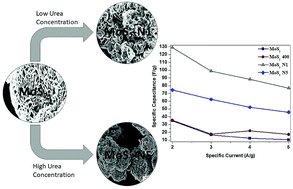Hierarchical nanostructures of nitrogen-doped molybdenum sulphide for supercapacitors†
Abstract
Flower-like nanostructures of molybdenum disulphide (MoS2) have been effectively synthesised by the hydrothermal method and further doped with nitrogen using varying concentrations of urea. The formed hierarchical nanostructures are characterised by spectroscopy as well as electrochemical techniques. The structural analysis confirms the formation of a hexagonal MoS2 crystal structure. The existence of MoO2/MoO3/MoS2 composites is also observed after heating MoS2 with a lower urea concentration. Surface morphological analysis of all the prepared compositions shows the appearance of flower-like nanostructures formed by the stacking of 20–80 nanosheets to create individual flower petals. Nitrogen doping shows enhancement in the specific capacitance of MoS2 due to an increase in the electronic conductivity. Furthermore, the specific capacitance is enhanced due to the formation of an MoO2/MoO3/MoS2 composite. The highest specific capacitance calculated from the charge–discharge curve for nitrogen-doped MoS2 prepared using 1 : 1 (MoS2 : urea) weight ratio is observed at around 129 (F g−1) at 2 (A g−1) specific current. The nitrogen-doped MoS2 demonstrates almost four-fold enhancement in specific capacitance than pristine nano-shaped MoS2.



 Please wait while we load your content...
Please wait while we load your content...